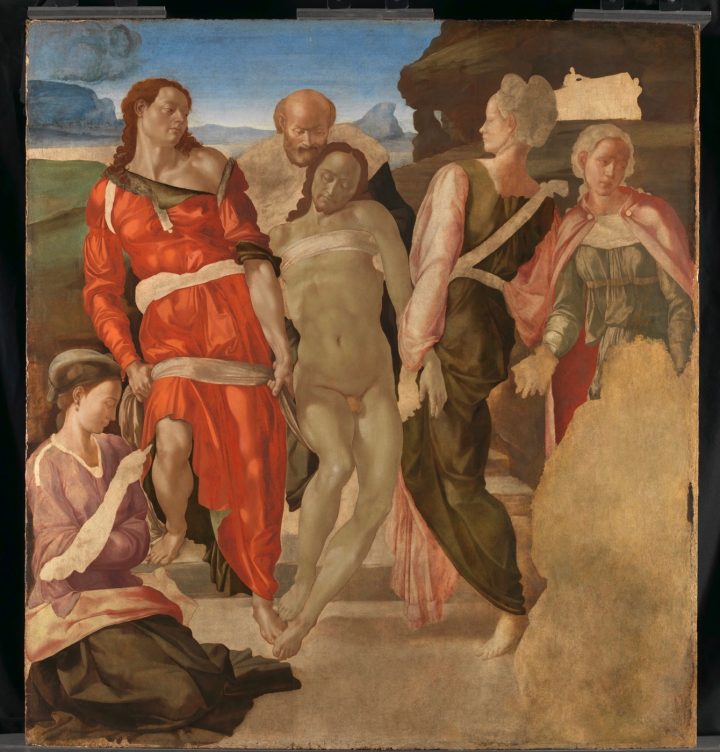Chronicling the Rivalry and Camaraderie of Michelangelo and Sebastiano
The exhibition methodically and academically does what it says on the tin:
offer compelling instances of collaboration and reveal the twists and turns
of a 25-year friendship and artistic relationship.


As such, it quickly becomes clear that curator Matthias Wivel is not out to champion del Piombo as an unsung master. Throughout the show, his work is shown to be decidedly clunky and lacking in comparison to the finesse and genius virtuosity of Michelangelo. Beginning with the Venetian-trained del Piombo’s arrival in Rome, the focus is exploration of the technical differences between the two artists within the context of fiercely competitive art patronage in Rome. We are thus invited to compare the working method behind Michelangelo’s “Virgin and Child with Saint John and Angels” (c. 1497) — its unfinished state revealing meticulously exact linear planning, green coloring of the dead flesh, and a piecemeal approach regarding covering the canvas surface — with del Piombo’s also unfinished “Judgement of Solomon” (c. 1506–09). With its underdrawing clearly showing hesitancy and a late-stage change in composition characteristic of an improvisatory way of working, it contrasts with Michelangelo’s determined precision. Del Piombo’s preference for an overall painterly fuzziness that evokes mood and atmosphere is consistent with the Venetian school of painting. Elsewhere, del Piombo’s Saints Bartholomew and Sebastian (c. 1510–11) from the doors of the Church of San Bartolomeo in Venice, similarly show a kind of all-over sfumato that fuzzes outlines, giving a murky, moody tone. In his paintings there is none of the distinguishing dynamism of the Florentine Michelangelo’s solid figures and strong composition.


In terms of concrete art historical evidence, the show works brilliantly with a methodical presentation of clear examples of the cross-pollination of ideas and designs between the two artists. The Vatican museums have loaned the Gallery a 1975 plaster cast of Michelangelo’s “Pietà” of 1497–1500, shown opposite del Piombo’s Pietà, or “Lamentation over the Dead Christ” (c. 1512–16). (Enjoy it — this is the closest you’ll get to the sculpture; the real thing should never leave its bulletproof case at St. Peter’s cathedral in Rome.) Each piece has its monumental, centrally positioned Virgin arranged to be perpendicular to the horizontal Christ, yet del Piombo makes innovative changes by including a nocturnal setting. More thrilling is the adjacent drawing by Michelangelo: a study of hands (among other bits and bobs), which is placed directly in the line of sight of the Virgin’s hands in del Piombo’s “Lamentation.” So displayed, it’s extremely hard to defy the argument that the former was a preparatory drawing for the latter. If this isn’t exciting enough, on the back of the “Lamentation” panel are sketches the National posits as studies consistent with designs in the Sistine Chapel; suggesting Michelangelo used this panel to sketch out designs and ideas eventually used there.

The same presentation occurs again for two main del Piombo showpieces, demonstrating a working relationship in which del Piombo blended into his oil painting drawings provided by Michelangelo. The near four-meter-tall “Raising of Lazarus” (1517–1519) — apparently del Piombo’s answer to Raphael’s “Transfiguration” (1516-20) — is surrounded by supporting drawings. Sensationally, del Piombo’s Borgherini Chapel in Rome has been reconstructed here using state of the art printing technology to add visual heft to the translation of Michelangelo’s preparatory drawings.
The rigorous, academic method of display absolutely makes this show. It is undeniable, looking at the key examples in the “Lamentation” and “Raising of Lazarus,” that there is little to distinguish del Piombo as a key Renaissance presence. The latter piece has been in the National’s collection since 1824, yet for all its scale and vibrant color it somehow still feels uninspiring and workman-like. That del Piombo was not a Renaissance master of the level of Michelangelo is confirmed in the final room covering their parting of ways after 1536.
.
No comments:
Post a Comment